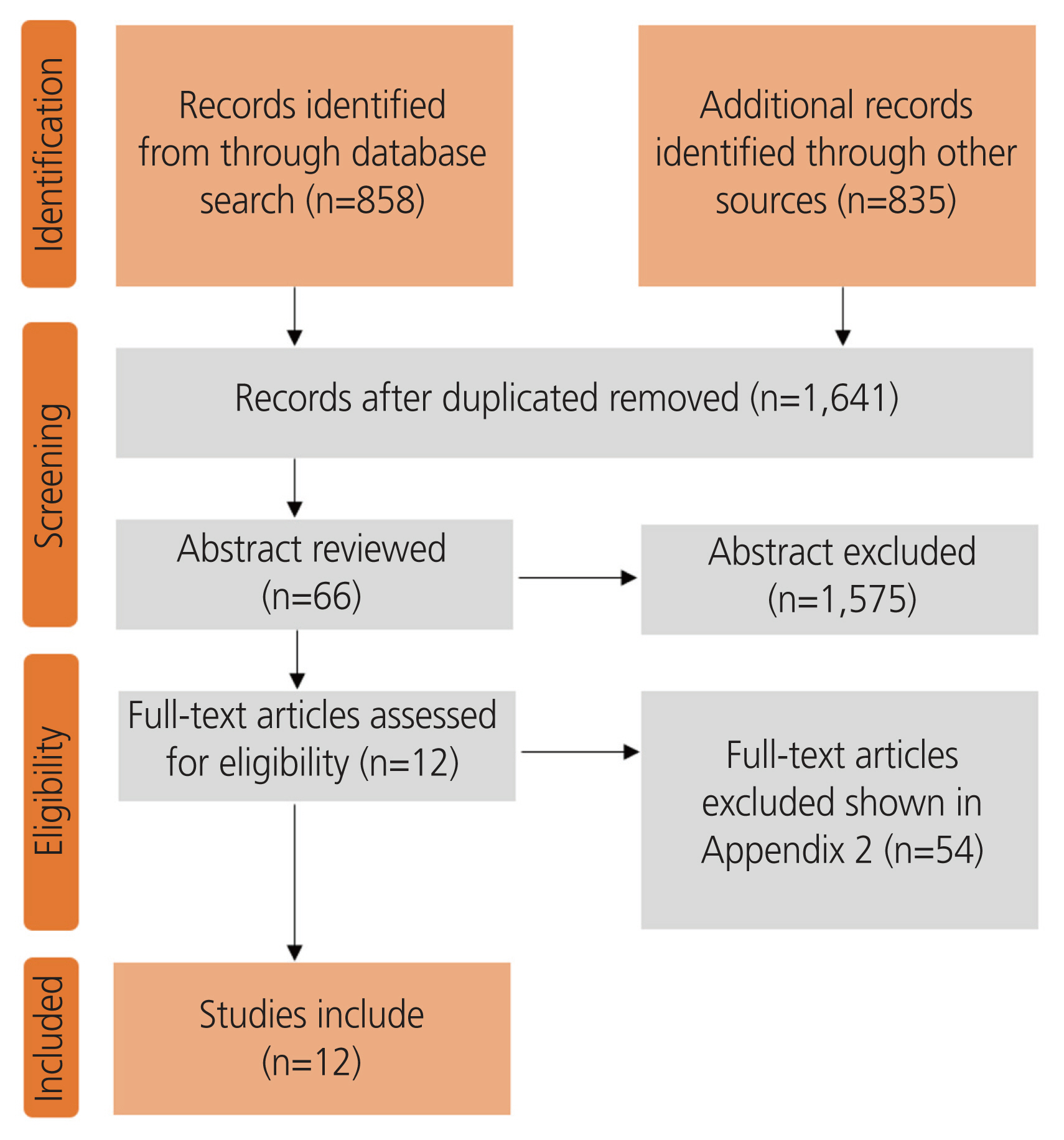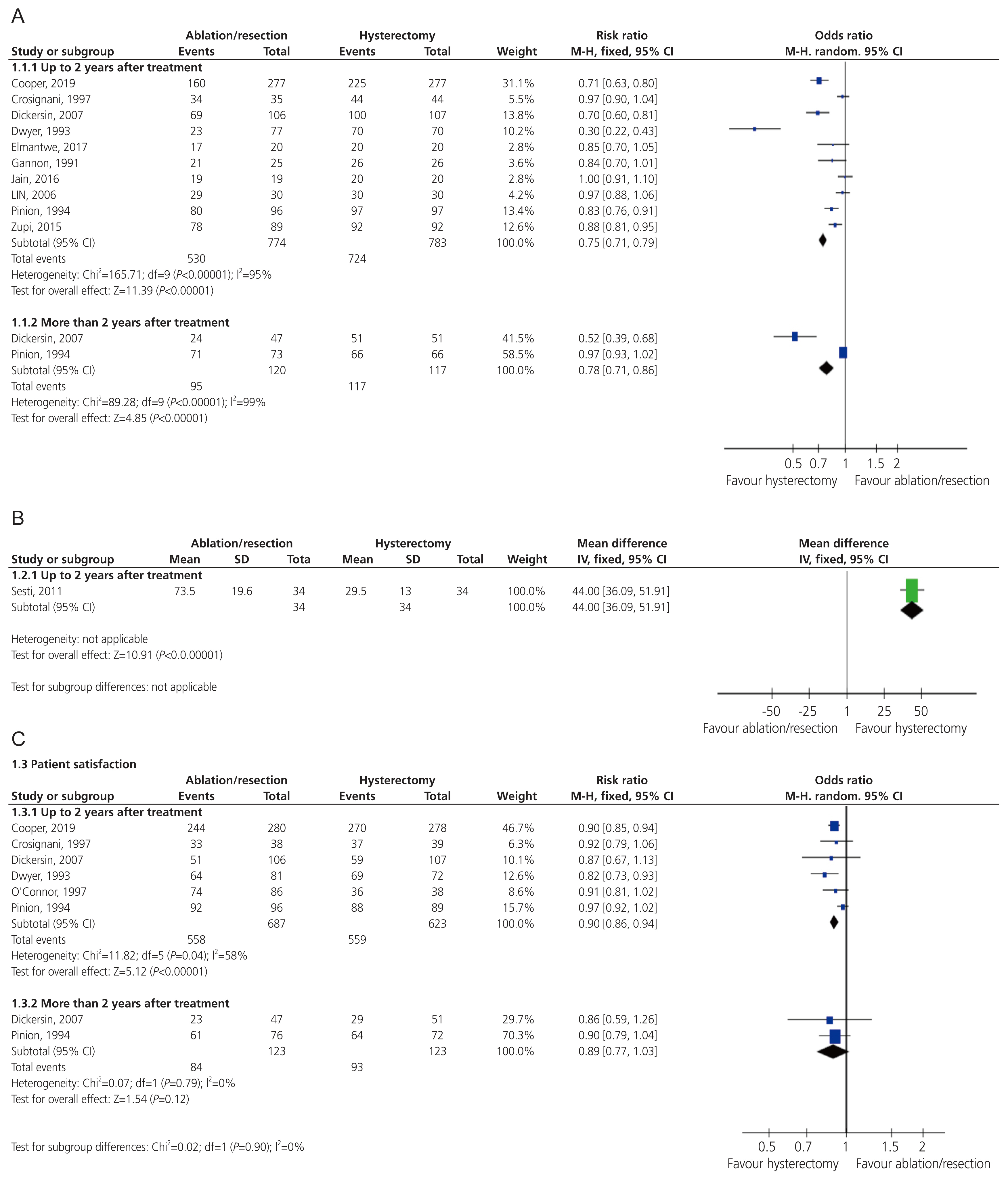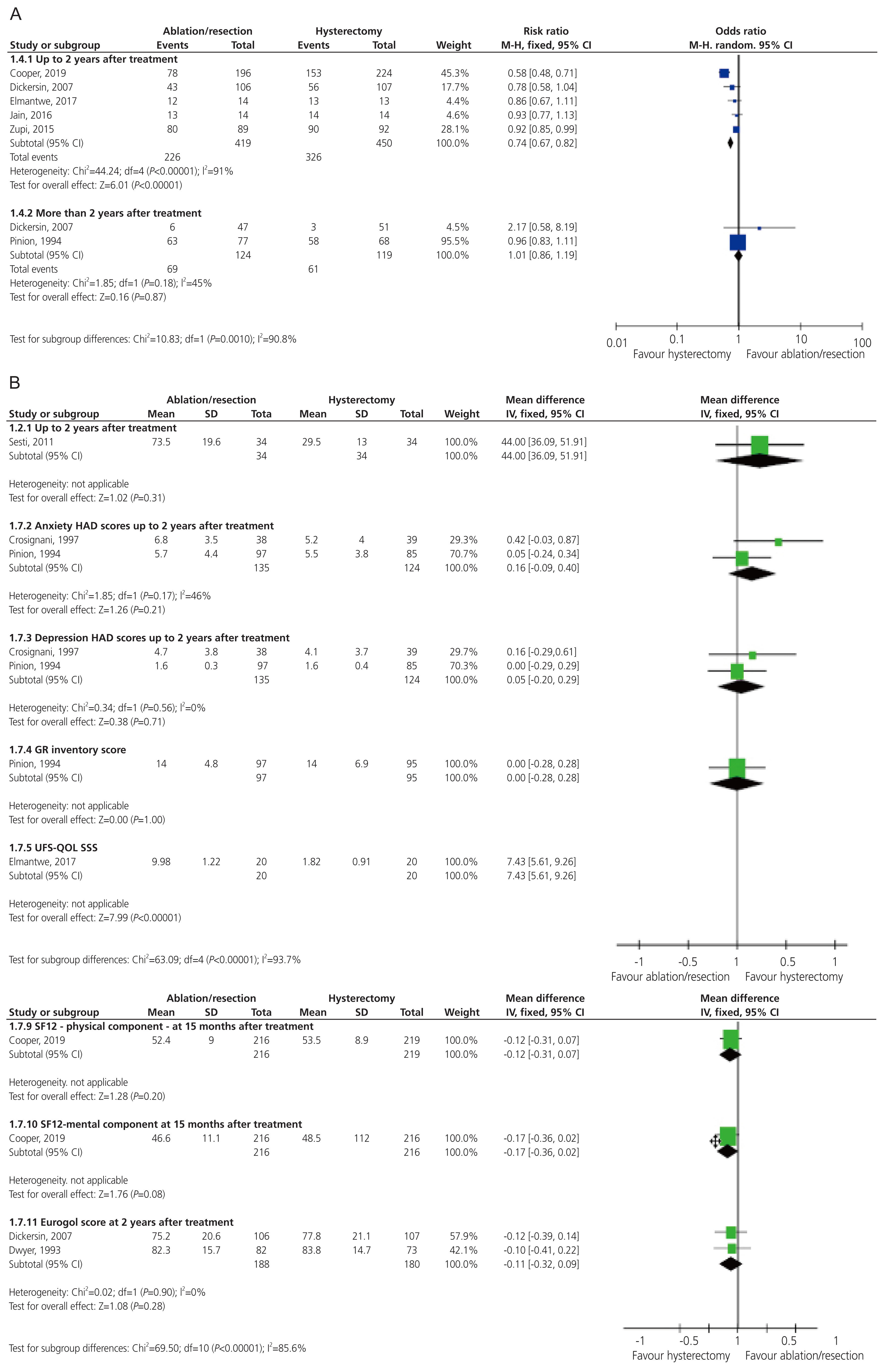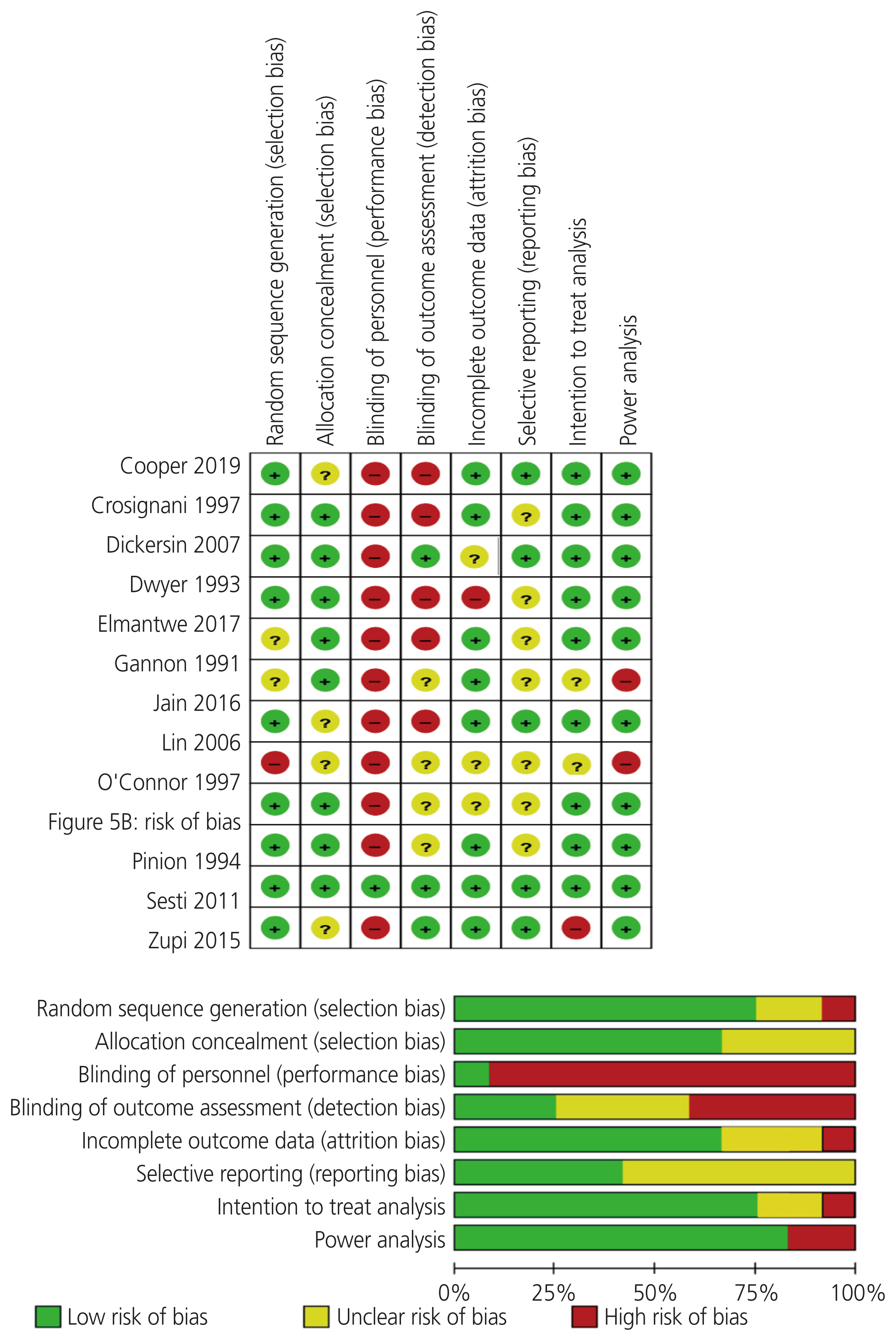Obstet Gynecol Sci.
2023 Sep;66(5):364-384. 10.5468/ogs.22308.
Endometrial ablation and resection versus hysterectomy for heavy menstrual bleeding: an updated systematic review and meta-analysis of effectiveness and complications
- Affiliations
-
- 1Medical Sciences and Nutrition, University of Aberdeen, School of Medicine, Aberdeen, UK
- KMID: 2545884
- DOI: http://doi.org/10.5468/ogs.22308
Abstract
- To evaluate the clinical efficacy, safety, and cost-effectiveness of endometrial ablation or resection (E:A/R) compared to hysterectomy for the treatment of heavy menstrual bleeding. Literature search was conducted, and randomized control trials (RCTs) comparing (E:A/R) versus hysterectomy were reviewed. The search was last updated in November 2022. Twelve RCTs with 2,028 women (hysterectomy: n=977 vs. [E:A/R]: n=1,051) were included in the analyzis. The meta-analysis revealed that the hysterectomy group showed improved patient-reported and objective bleeding symptoms more than those of the (E:A/R) group, with risk ratios of (mean difference [MD], 0.75; 95% confidence intervals [CI], 0.71 to 0.79) and (MD, 44.00; 95% CI, 36.09 to 51.91), respectively. Patient satisfaction was higher post-hysterectomy than (E:A/R) at 2 years of follow-up, but this effect was absent with long-term follow-up. (E:A/R) is considered an alternative to hysterectomy as a surgical management for heavy menstrual bleeding. Although both procedures are highly effective, safe, and improve the quality of life, hysterectomy is significantly superior at improving bleeding symptoms and patient satisfaction for up to 2 years. However, it is associated with longer operating and recovery times and a higher rate of postoperative complications. The initial cost of (E:A/R) is less than the cost of hysterectomy, but further surgical requirements are common; therefore, there is no difference in the cost for long-term follow-up.
Figure
Reference
-
References
1. NICE guideline. Heavy menstrual bleeding: assessment and management [Internet]. London (UK): National Institute for Health and Care Excellence;c2018. [cited 2020 May 17]. Available from: https://www.nice.org.uk/guidance/ng88/resources/heavy-menstrual-bleeding-assessment-and-management-pdf-1837701412549 .2. Selvanathan S, Acharya N, Singhal S. Quality of life after hysterectomy and uterus-sparing hysteroscopic management of abnormal uterine bleeding or heavy menstrual bleeding. J Midlife Health. 2019; 10:63–9.3. NHS. Complications: hysterectomy [Internet]. London (UK): NHS;c2020. [cited 2020 May 16]. Available from: https://www.nhs.uk/conditions/hysterectomy/risks/ .4. Fergusson RJ, Bofill Rodriguez M, Lethaby A, Farquhar C. Endometrial resection and ablation versus hysterectomy for heavy menstrual bleeding. Cochrane Database Syst Rev. 2019; 8:CD000329.5. Roberts TE, Tsourapas A, Middleton LJ, Champaneria R, Daniels JP, Cooper KG, et al. Hysterectomy, endometrial ablation, and levonorgestrel releasing intrauterine system (mirena) for treatment of heavy menstrual bleeding: cost effectiveness analysis. BMJ. 2011; 342:d2202.6. Bofill Rodriguez M, Lethaby A, Fergusson RJ. Endometrial resection and ablation versus hysterectomy for heavy menstrual bleeding. Cochrane Database Syst Rev. 2021; 2:CD000329.7. Higgins JP, Thomas J, Chandler J, Cumpston M, Li T, Page MJ, et al. Cochrane handbook for systematic reviews of interventions. 2nd ed. London: John Wiley & Sons;2019.8. Eupati. Quasi-randomised trial [Internet]. Utrecht (NL): Eupati;c2022. [cited 2022 May 17]. Available from: https://toolbox.eupati.eu/glossary/quasi-randomised-trial/ .9. Liberati A, Altman DG, Tetzlaff J, Mulrow C, Gøtzsche PC, Ioannidis JP, et al. The PRISMA statement for reporting systematic reviews and meta-analyses of studies that evaluate health care interventions: explanation and elaboration. PLoS Med. 2009; 6:e1000100.10. Review Manager. RevMan version 5.3 [Internet]. Copenhagen (DK): Review Manager;c2014. [cited 2019 Jul 18]. Available from: https://revman.cochrane.org/#/myReviews .11. Cochrane. Mantel-haenszel method [Internet]. London (UK): Cochrane;c2020. [cited 2020 Oct 25]. Available from: http://www.cochrane.org/training/XXXochrane-handbook .12. Higgins JP, Thompson SG, Deeks JJ, Altman DG. Measuring inconsistency in meta-analyses. BMJ. 2003; 327:557–60.13. Nikolakopoulou A, Mavridis D, Salanti G. How to interpret meta-analysis models: fixed effect and random effects meta-analyses. Evid Based Ment Health. 2014; 17:64.14. McMaster University. GRADEpro GDT [Internet]. Hamilton (ON): McMaster University;c2015. [cited 2019 Jul 19]. Available from: https://cebgrade.mcmaster.ca/ .15. Cooper K, Breeman S, Scott NW, Scotland G, Clark J, Hawe J, et al. Laparoscopic supracervical hysterectomy versus endometrial ablation for women with heavy menstrual bleeding (HEALTH): a parallel-group, open-label, randomised controlled trial. Lancet. 2019; 394:1425–36.16. Dickersin K, Munro MG, Clark M, Langenberg P, Scherer R, Frick K, et al. Hysterectomy compared with endometrial ablation for dysfunctional uterine bleeding: a randomized controlled trial. Obstet Gynecol. 2007; 110:1279–89.17. Jain P, Rajaram S, Gupta B, Goel N, Srivastava H. Randomized controlled trial of thermal balloon ablation versus vaginal hysterectomy for leiomyoma-induced heavy menstrual bleeding. Int J Gynaecol Obstet. 2016; 135:140–4.18. Lin H. Comparison between microwave endometrial ablation and total hysterectomy. Chin Med J (Engl). 2006; 119:1195–7.19. Sesti F, Ruggeri V, Pietropolli A, Piancatelli R, Piccione E. Thermal balloon ablation versus laparoscopic supracervical hysterectomy for the surgical treatment of heavy menstrual bleeding: a randomized study. J Obstet Gynaecol Res. 2011; 37:1650–7.20. Crosignani PG, Vercellini P, Apolone G, De Giorgi O, Cortesi I, Meschia M. Endometrial resection versus vaginal hysterectomy for menorrhagia: long-term clinical and quality-of-life outcomes. Am J Obstet Gynecol. 1997; 177:95–101.21. Gannon MJ, Holt EM, Fairbank J, Fitzgerald M, Milne MA, Crystal AM, et al. A randomised trial comparing endometrial resection and abdominal hysterectomy for the treatment of menorrhagia. BMJ. 1991; 303:1362–4.22. O’Connor H, Broadbent JA, Magos AL, McPherson K. Medical research council randomised trial of endometrial resection versus hysterectomy in management of menorrhagia. Lancet. 1997; 349:897–901.23. Dwyer N, Hutton J, Stirrat GM. Randomised controlled trial comparing endometrial resection with abdominal hysterectomy for the surgical treatment of menorrhagia. Br J Obstet Gynaecol. 1993; 100:237–43.24. Zupi E, Centini G, Lazzeri L, Finco A, Exacoustos C, Afors K, et al. Hysteroscopic endometrial resection versus laparoscopic supracervical hysterectomy for abnormal uterine bleeding: long-term follow-up of a randomized trial. J Minim Invasive Gynecol. 2015; 22:841–5.25. Elmantwe A. Bipolar endometrial resection (BER) versus non descent vaginal hysterectomy (NDVH) for leiomyoma induced heavy menstrual bleeding. EFSS. 2017; 21:9–16.26. Pinion SB, Parkin DE, Abramovich DR, Naji A, Alexander DA, Russell IT, et al. Randomised trial of hysterectomy, endometrial laser ablation, and transcervical endometrial resection for dysfunctional uterine bleeding. BMJ. 1994; 309:979–83.27. Cooper K, Lee A, Chien P, Raja E, Timmaraju V, Bhattacharya S. Outcomes following hysterectomy or endometrial ablation for heavy menstrual bleeding: retrospective analysis of hospital episode statistics in Scotland. BJOG. 2011; 118:1171–9.28. Middleton LJ, Champaneria R, Daniels JP, Bhattacharya S, Cooper KG, Hilken NH, et al. Hysterectomy, endometrial destruction, and levonorgestrel releasing intrauterine system (Mirena) for heavy menstrual bleeding: systematic review and meta-analysis of data from individual patients. BMJ. 2010; 341:c3292.29. Waljee J, McGlinn EP, Sears ED, Chung KC. Patient expectations and patient-reported outcomes in surgery: a systematic review. Surgery. 2014; 155:799–808.30. Minalt N, Canela CD, Marino S. Endometrial ablation [Internet]. Treasure Island (FL): StatPearls Publishing;c2022. [cited 2022 May 17]. Available from: https://www.ncbi.nlm.nih.gov/books/NBK459245/#_NBK459245_pubdet_ .31. Brandsborg B, Nikolajsen L, Hansen CT, Kehlet H, Jensen TS. Risk factors for chronic pain after hysterectomy: a nationwide questionnaire and database study. Anesthesiology. 2007; 106:1003–12.32. Talukdar S, Underwood J, Atkinson S, Sangha R. Who will suffer from postablation pelvic pain? A retrospective analysis of risk factors [7Q]. Obstet Gynecol Sci. 2016; 127:141S.33. Thomassee MS, Curlin H, Yunker A, Anderson TL. Predicting pelvic pain after endometrial ablation: which preoperative patient characteristics are associated? J Minim Invasive Gynecol. 2013; 20:642–7.34. Clarke-Pearson DL, Geller EJ. Complications of hysterectomy. Obstet Gynecol. 2013; 121:654–73.35. Matteson KA, Abed H, Wheeler TL 2nd, Sung VW, Rahn DD, Schaffer JI, et al. A systematic review comparing hysterectomy with less-invasive treatments for abnormal uterine bleeding. J Minim Invasive Gynecol. 2011; 19:13–28.36. Overton C, Hargreaves J, Maresh M. A national survey of the complications of endometrial destruction for menstrual disorders: the MISTLETOE study. Minimally invasive surgical techniques--laser, endothermal or endorescetion. Br J Obstet Gynaecol. 1997; 104:1351–9.37. Danesh M, Hamzehgardeshi Z, Moosazadeh M, Shabani-Asrami F. The effect of hysterectomy on women’s sexual function: a narrative review. Med Arch. 2015; 69:387–92.38. Garry R, Fountain J, Mason S, Hawe J, Napp V, Abbott J, et al. The eVALuate study: two parallel randomised trials, one comparing laparoscopic with abdominal hysterectomy, the other comparing laparoscopic with vaginal hysterectomy. BMJ. 2004; 328:129.39. Bofill Rodriguez M, Lethaby A, Grigore M, Brown J, Hickey M, Farquhar C. Endometrial resection and ablation techniques for heavy menstrual bleeding. Cochrane Database Syst Rev. 2019; 1:CD001501.40. Cancelliere C, Donovan J, Stochkendahl MJ, Biscardi M, Ammendolia C, Myburgh C, et al. Factors affecting return to work after injury or illness: best evidence synthesis of systematic reviews. Chiropr Man Therap. 2016; 24:32.41. Miller JD, Lenhart GM, Bonafede MM, Lukes AS, Laughlin-Tommaso SK. Cost-effectiveness of global endometrial ablation vs. hysterectomy for treatment of abnormal uterine bleeding: US commercial and medicaid payer perspectives. Popul Health Manag. 2015; 18:373–82.42. Sculpher MJ, Dwyer N, Byford S, Stirrat GM. Randomised trial comparing hysterectomy and transcervical endometrial resection: effect on health related quality of life and costs two years after surgery. Br J Obstet Gynaecol. 1996; 103:142–9.43. A randomised trial of endometrial ablation versus hysterectomy for the treatment of dysfunctional uterine bleeding: outcome at four years. Aberdeen endometrial ablation trials group. Br J Obstet Gynaecol. 1999; 106:360–6.44. Cameron IM, Mollison J, Pinion SB, Atherton-Naji A, Buckingham K, Torgerson D. A cost comparison of hysterectomy and hysteroscopic surgery for the treatment of menorrhagia. Eur J Obstet Gynecol Reprod Biol. 1996; 70:87–92.45. Alexander DA, Naji AA, Pinion SB, Mollison J, Kitchener HC, Parkin DE, et al. Randomised trial comparing hysterectomy with endometrial ablation for dysfunctional uterine bleeding: psychiatric and psychosocial aspects. BMJ. 1996; 312:280–4.46. Hall JC, Mills B, Nguyen H, Hall JL. Methodologic standards in surgical trials. Surgery. 1996; 119:466–72.47. Nikolova D, Klingenberg SL, Gluud C. The cochrane hepato-biliary group as a resource example of evidence-based medicine for all. Acta Med Port. 2013; 26:81–2.48. Gurusamy K, Aggarwal R, Palanivelu L, Davidson BR. Systematic review of randomized controlled trials on the effectiveness of virtual reality training for laparoscopic surgery. Br J Surg. 2008; 95:1088–97.
- Full Text Links
- Actions
-
Cited
- CITED
-
- Close
- Share
- Similar articles
-
- Pathophysiology and Treatment Guidelines of Dysfunctional Uterine Bleeding
- Effectiveness of Levonorgestrel Releasing Intrauterine System in Perimenopausal Women with Heavy Menstrual Bleeding: A Prospective Study at a Teaching Hospital in India
- Endometrial carcinoma in an asymptomatic patient using the levonorgestrel-releasing intrauterine system
- Hysteroscopic Endometrial Ablation as a Treatment of Abnormal Uterine Bleeding in Renal Transplant Patients
- Levonorgestrel-Releasing Intrauterine System Use in Perimenopausal Women






